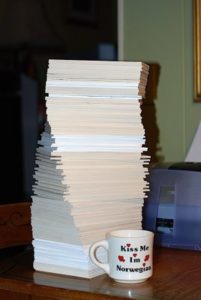 Marc Hanson, is a talented artist friend who caught my eye not only for his beautiful paintings, but for all the clever art tips, like making your own panels, he shares on Facebook with his adoring fans.
Marc Hanson, is a talented artist friend who caught my eye not only for his beautiful paintings, but for all the clever art tips, like making your own panels, he shares on Facebook with his adoring fans.
Marc is a world class artist and recently won the Oil Painters of America, ‘John Marion Pardy Landscape Award of Excellence’ for the painting ‘Sunday Morning Frost,’ a 16×20 oil.
A while back, Marc shared a popular article with Fine Art Tips, “Save Studio Space! How to Make Your Own Painting Racks” and since then people have been asking about the small panels that he uses to fill these racks.
(This is a stack of 120 panels all ready for priming or for having linen mounted to them.)
Marc makes his own small panels from 8 Ply 100% Rag Museum Board. He uses Crescent board.
- Marc says if you Google ‘8 ply museum rag board’ there are quite a few suppliers who show up. B&H Photo is one that shows up the most.
- Also try frame suppliers, frame shops, and some art supply stores. Sheets are 32×40 I think. There are elephant sized sheets also available… 40×60.
Marc first cuts the panels out with a mat knife (utility knife) and an aluminum ruler.
He primes them either with a coat of shellac, a thin coat of acrylic primer with pumice and then shellac or he glues linen or canvas directly to the panel using, Miracle Muck.
A few interesting facts about Shellac:
- Shellac has been used for centuries as an isolator for many finishing and ‘Art’ uses.
- A friend Marc’s who used to be a professional restorer told him that the hardest paint to remove from an old painting was paint that had been applied to a surface with shellac as the primer.
- The framers out there will know this saying, “Shellac sticks to anything and anything sticks to shellac.”
- It’s only two draw backs are that if applied too thick it can crack, and it is not water impervious. But if you are bending or soaking your paintings, you have problems anyway! 😉
As for permanence, Marc takes the 8 ply 100% rag board any day over the Gator board.
- He does not like the way the foam gasses off and will eventually deteriorate.
- Plus the Gator board can be punctured or dented to the point of ruining the surface of the painting.
- The 100% rag, if properly isolated from the paint, and taken care of as you would any painting support, will be here hundreds of years from now.
That said, if Marc plans on painting larger than about an 8×10 using the museum board, he would glue it down onto another support, probably composition hard board that has had the surface isolated with urethane floor varnish.
Marc says it works great.
*****
 Thanks again Marc for sharing a great tip with us 🙂
Thanks again Marc for sharing a great tip with us 🙂
You might also like to read:
Save Money! Learn How to Gesso a Hardboard Panel for Painting
How to Bring out the Mona Lisa in Your Own Artwork!









This is great, I can’t wait to try this! Thanks so much to both of you, I’ll be linking.
Thank for stopping by and commenting. Let us know how it works for you.
Best-
Lori 🙂
Great site. A lot of useful information here. I’m sending it to some friends!
I always wonder if these type of comments are spam??? However it is not impossible that you are a physician assistant who is interested in art and reading this website on your coffee break – lol! I hope so…thanks.
Lori